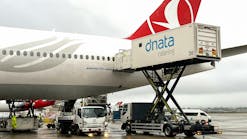Near the beginning of the year, Airlines for America (A4A) updated its ATA 103 standard for jet fuel quality control to allow for the use of water barrier filters and phase out filters utilizing super absorbent polymers (SAP).
A4A’s update and the need to eliminate monitor filters containing SAP comes from several incidents where the material was found to be the cause of inoperability in aircraft fuel systems.
“Between 2010 and 2017 there were eight documented incidents in which SAP was identified as the cause of operability issues within aircraft fuel systems,” says Steve Berry, manager of fuel quality and safety, National Air Transportation Association (NATA).
“Filters are supposed to be filtering out contaminants, not adding to it,” he continues. “And then the decision was made that we need to phase them out. And then that started the process of looking for replacement technology.”
The decision to phase out monitor filters began in 2017 and required a drop-in replacement given how ubiquitous they are in the industry. Estimates at the time, Berry says, showed around 85 percent of all aviation fuel filtration worldwide was monitor filters.
Dropping In
The new replacement technology to SAP – water barrier filters – has been developed by Parker Velcon and does just as the name suggests, repels water as opposed to absorbing it.
“The EI 1583 specification that came out many, many years ago, probably about over 40 years ago, was a filter design that used a media that trapped absorbed water and would not let it pass through. And this CDFX cartridge water barrier filter does not absorb water. It repels water. So any water that's in the influence side of the aviation fuel will be repelled and collected at the bottom of the filter vessel, as opposed to being absorbed into the filter cartridges,” describes Robert Guglielmi, business development manager, global, Parker Velcon.
The water barrier filters are the same size as the existing filter and it fits into the filter housing the same way. There's no requirement to do anything differently to the filter housing. Guglielmi describes them as “plug and play,” with the only difference being how they repel instead of absorb water.
However, that distinction means the new filters are somewhat different operationally.
“You need to do water checks every day to make sure if any water has been stripped away, that it is removed from the bottom of the filter vessel. And also, the differential pressure recording that operators have to do daily for all fuelings is slightly different,” Guglielmi says.
The change to differential pressure (DP) is the most significant change that the new filters bring to everyday fueling operations. With SAP filters, spikes in DP were cause for alarm, but not so much with water barrier filters.
“Historically with any filtration technology, differential pressure should only ever increase under the same flow rate, right? If you have a … [jump] in DP under the same flow rate, historically that's a giant red flag that something has gone on, that fuel is bypassing the filter,” Berry explains. “With the water barriers though, because of the way they work, they don't absorb water. So, with that, if you had a slug of water come through and you had a spike in DP and then you drain that water off and the DP normalized, then that's acceptable.”
“There may be at times where it is stripping water,” adds Guglielmi. “The differential pressure will increase. And when that water is removed, the differential pressure could slightly decrease back to a lower pressure. And that's not any concern for alarm because it does a different application than the older monitor operation.”
However, drops in DP are still a red flag and need to be addressed.
“Now you still need to be concerned if you go from, say, five [DP] to zero. That still means that something's ruptured or come unseated,” Berry says.
No Mix Ups
Outside of the difference to recording DP, the other main consideration with the water barrier filters is not confusing them with the SAP filters that are being phased out, as the two filters look nearly identical.
“They are virtually indistinguishable with the exception of the markings on the end caps,” says Berry. “One says CDF 230 and the other one says CDFX 230.”
“So, if you start introducing the water barrier filter, you have to be very careful and thorough with the way you are storing them or marking them, or what vehicles have been transitioned over, converted over to the water barrier filter,” Guglielmi says. “What we don't want and what the industry regulators don't want is to see mixing, and potentially mixing and matching of the two different technologies.”
And it’s more than just a hypothetical possibility – during field trials of the new filters, there was an instance of a mix-up occurring.
“They went to go pull some of the elements that were being tested in the field trials and realized, well, somebody put in monitor filters and not water barrier filters. So that segregated storage is important,” Berry says.
“You need to be very cautious of what cartridges you're putting into your filter vessel and that you're not potentially mixing and using different cartridge designs,” stresses Guglielmi.
Aside from DP differences and mitigating the risk of mix-ups, the filters are largely identical to the SAP filters.
“These cartridges are tested and approved to remove both contaminate and water levels within the specifications required. So again, there's no requirement for any additional equipment to do that. There's no additional monitoring equipment or any other equipment that is required to add to your system,” Guglielmi says.
The filters are also tested for use with additives, as well.
For example, in the general aviation industry, fuel system icing inhibitor (FSII) is often used.
“It's an anti-icing additive, and fuel that is pre-blended with the anti-icing additive can now be used with this water barrier technology where it was not allowed to be used with the prior 1583 monitor,” Guglielmi says.
Phasing In
As the roll out of water barrier filters continues, SAP filters are still being allowed at the moment.
“There's no longer specification for the water absorbing cartridges – the SAP monitor. However, they're still being used under a guidance from the ATA and JIG groups. And as long as they're following those guidelines and mitigating the risk, they can still continue using them for the time being,” Guglielmi said.
The Joint Inspection Group (JIG) is allowing the use of SAP monitors through June 2023, after which they will no longer be part of their standard. Berry says he does not anticipate there to be widespread adoption of water barrier filters until closer to the 2023 date.
“I think the adoption rate is absolutely going to depend on when people can no longer use them, when they're no longer accepted into whatever standard it is that a refueling operator is operating to, and in the US, that's primarily the ATA 103,” Berry says. “Outside the US, you've got that June 2023 date.”
Berry says he anticipates the US to mirror the June 2023 timeframe for water barrier filter adoption. Adoption before then will likely be influenced by a company’s cost analysis for switching filters.
“If I have up to a year and I'm due for a filter change, I'm going to save a few pennies and go with the technology that's still acceptable and still able to be used,” he says. “But once that date occurs or you get within a year of that date, it wouldn't make sense to spend X number of dollars on monitor filters and then have to change them in six months and go with the new ones.”






